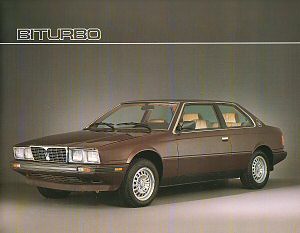 On the 14th December of 1981, the 67th anniversary of the founding of 'Officine Alfieri Maserati', Maserati leaped back into the news with the launch of the 'Biturbo'. This car was to mark the relaunch of the prestigious marque, following their deep crises back in the early seventies. On the 14th December of 1981, the 67th anniversary of the founding of 'Officine Alfieri Maserati', Maserati leaped back into the news with the launch of the 'Biturbo'. This car was to mark the relaunch of the prestigious marque, following their deep crises back in the early seventies.
The concept of the Biturbo (twin turbochargers) began back in the autumn of 1978, when that great entrepreneur Alejandro De Tomaso, new owner of the 'Casa del Tridente', decided that the time was right to produce a mass-produced Maserati coupe at an affordable price.
The first heavily disguised prototypes of this new coupe could be seen undergoing trials on the outskirts of Modena during early 1980. The car, which inherited certain style elements from the 'Quattroporte III' of 1979, bore a wedge-shaped design so typical of that period.
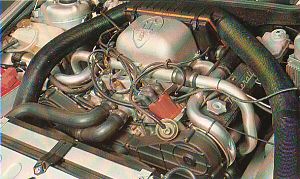 The Biturbo (1981-1984) adopted a classic mechanical configuration; front-engined with rear-wheel drive. The power unit, developed by De Tomaso, was derived from the 6 cylinder 90° V 1996 cc engine mounted on the Merak 2000 (which in its turn was derived from the engine Giulio Alfieri designed for the 'Citroen SM'). There were however substantial modifications: the adoption of three valves per cylinder, two intake and one exhaust, and two overhead camshafts (one per bank) instead of four; these were no longer driven by a timing chain but replaced by the quieter toothed belt. Bore and stroke changed from 80 x 66.3 mm to 82 x 63.5 mm and the three Weber 42 DCNF carburettors were replaced by a 'supercharged' system using a single twin-choke Weber carburettor, housed in a sealed plenum chamber, fed by two small Japanese IHI turbochargers. Power output was 180 bhp at 6000 rpm, sufficient to give the Biturbo a top speed of 135 mph and to accelerate it from rest to 60 mph in 6½ seconds. The Biturbo (1981-1984) adopted a classic mechanical configuration; front-engined with rear-wheel drive. The power unit, developed by De Tomaso, was derived from the 6 cylinder 90° V 1996 cc engine mounted on the Merak 2000 (which in its turn was derived from the engine Giulio Alfieri designed for the 'Citroen SM'). There were however substantial modifications: the adoption of three valves per cylinder, two intake and one exhaust, and two overhead camshafts (one per bank) instead of four; these were no longer driven by a timing chain but replaced by the quieter toothed belt. Bore and stroke changed from 80 x 66.3 mm to 82 x 63.5 mm and the three Weber 42 DCNF carburettors were replaced by a 'supercharged' system using a single twin-choke Weber carburettor, housed in a sealed plenum chamber, fed by two small Japanese IHI turbochargers. Power output was 180 bhp at 6000 rpm, sufficient to give the Biturbo a top speed of 135 mph and to accelerate it from rest to 60 mph in 6½ seconds.
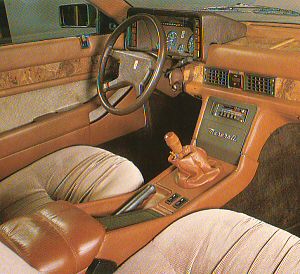 In order to keep down costs, and market the Biturbo at a competitive price, Maserati proposed a production rate of 30-35 cars per day, 7500 to 8750 per annum. An ambitious programme when you consider that previously their most successful model at that time was the Quattroporte III, whose production didn't exceed 3 a day. In order to keep down costs, and market the Biturbo at a competitive price, Maserati proposed a production rate of 30-35 cars per day, 7500 to 8750 per annum. An ambitious programme when you consider that previously their most successful model at that time was the Quattroporte III, whose production didn't exceed 3 a day.
The Modenese factory, which still adopted 'artisan' manufacturing practices, was in no position to sustain such an ambitious production plan. Production and painting of the bodyshells was therefore entrusted to Innocenti, at its Lambrate factory in Milan; as was the final assembly and testing. The factory in Modena was to manufacture only the engines and suspension units, the former at a rate of forty per day, which were then transported to Milan for final assembly.
The Biturbo immediately captured the imagination of the Italian public and only a few weeks following its launch, concessionaires boasted full order books. Success was largely due to its affordable price, its superlative performance and the prestige of the Trident marque. Its engine size, intentionally kept below two litres in order to avoid the punitive 38% value added tax levied on engines above two litres, also made it an attractive prospect.
No sooner were the first examples being delivered that the car was already in the middle of heated controversies, fuelled in particular by the ill advised price structure put into effect by Maserati. Launched with the incredible low price of only Lire 16.700.000 (around GB £7,200), within six months 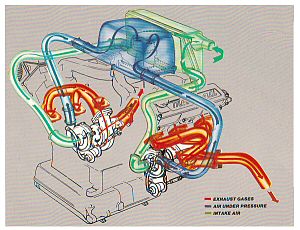 the price of the new coupe was increased to Lire 22,236,000 (around GB £9,500), an increase of almost 34%. the price of the new coupe was increased to Lire 22,236,000 (around GB £9,500), an increase of almost 34%.
Unfortunately these early cars were beset with mechanical and unreliability problems: common faults being seized turbochargers, broken timing belts, difficult engine starting when hot, and numerous minor electical faults. This added to the poor build quality aroused doubts and concerns. The poor treatment of the sheet metal, for example, rendered the bodywork particularly sensitive to rust: even some of the new body panels were often already suffering from corrosion.
In spite of the fact that, over a period of time, many of these teething problems were eventually resolved, public confidence in the Biturbo had been lost and unfortunately for Maserati, it was never fully restored until much later.
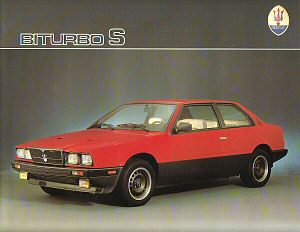 Before continuing, one should bear in mind that in the Biturbo, Maserati had produced a very quick car at an extremely competitive price that was made available to many more drivers, most of whom had no experience of driving and handling such fast cars. It followed that although some of these complaints were justified, many weren't. Before continuing, one should bear in mind that in the Biturbo, Maserati had produced a very quick car at an extremely competitive price that was made available to many more drivers, most of whom had no experience of driving and handling such fast cars. It followed that although some of these complaints were justified, many weren't.
Many owners, with their exhuberant driving techniques, would exceed the rev limit recommended by the factory - resulting in broken timing belts. Others would forget or not bother to let the engine idle for a period prior to switching it off, as explained in their driver's handbook, with the obvious result - seized turbochargers. Some unsuspecting drivers didn't realise that these early cars had a 'black box' which indicated when and if an owner had exceed the recommended rev limit, thereby invalidating any warranty.
In 1983 the range was increased with the presentation of 'Biturbo S' (1983-1986), reserved solely for the domestic market and produced as a limited series. This sport version was distinguishable 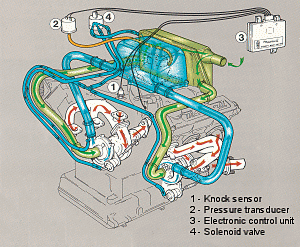 by its two tone paint work, the NACA vents on the engine bonnet, a sportier radiator grille, its burnished metal trim, the re-designed wheels shod with Pirelli P7 tyres and a velour upholstered interior designed by Ottavio Missoni. Power output, thanks to the use of two air-to-air intercoolers, was raised to 205 bhp (25 bhp more than the standard Biturbo) and the car was given stiffer sports suspension. by its two tone paint work, the NACA vents on the engine bonnet, a sportier radiator grille, its burnished metal trim, the re-designed wheels shod with Pirelli P7 tyres and a velour upholstered interior designed by Ottavio Missoni. Power output, thanks to the use of two air-to-air intercoolers, was raised to 205 bhp (25 bhp more than the standard Biturbo) and the car was given stiffer sports suspension.
With the introduction of the 'S' version came an important addition to the entire Biturbo range, the installation of the 'MABC' (Maserati Automatic Boost Control) system. The system, developed with the co-operation of SAAB, used an electronic control unit with sensors to monitor boost pressure and prevent pre-ignition (see illustration).
For the export market Maserati produced the 'Biturbo ES' (1984-1988) which was powered by a 2.5-litre engine developing 190 bhp at 5,500 rpm.
In December 1983, exactly two years after the debut of the Biturbo coupe, Maserati launched 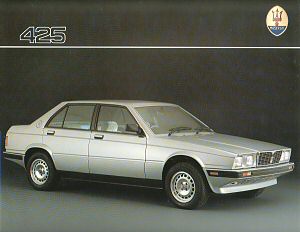 a four-door version, called the 'Biturbo 425' (1983-1989). a four-door version, called the 'Biturbo 425' (1983-1989).
The wedge-shape line of the two-door coupe was emphasised by its greater length (173.22 ins instead of 163.5 ins) and its higher tail; also increased was the wheelbase (from 98.97 to 102.36 ins) and the width (from 67.48 to 68.11 ins). Substantial changes were made to the interior; including a new semi-circular shaped instrument binnacle and the push-button control switches (previously housed in the rectangular instrument binnacle) were now positioned in a row just above the air conditioning control panel in the centre of the dashboard. The seats and trim were now upholstered in Missoni velour.
The 2.5-litre engine was derived from that fitted to the export version of the coupe, a 2491cc V6 with three valves per cylinder but now yielding 200 bhp at 5500 rpm.
The 425 was marketed with a price tag of Lire 30,317,000 (around GB £12,700), 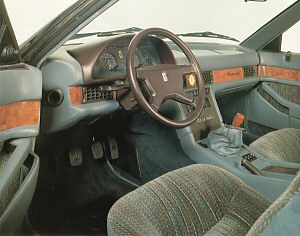 a sum to which had to be added an extra Lire 5,200,000 (around GB £2,200) for the 'obligatory' optionals such as air conditioning and alloy wheels. a sum to which had to be added an extra Lire 5,200,000 (around GB £2,200) for the 'obligatory' optionals such as air conditioning and alloy wheels.
To satisfy the requirements of their Italian market, in 1985 Maserati introduced the 'Biturbo 420' (1985-1986), identical to the 425, but with the 1996cc engine of the coupe. Later that year, Maserati added the '420S' (1985-1987), equipped with the same 205 bhp engine as the 'Biturbo S' coupe, to the range.
1984 saw the launch of the 'Biturbo Spyder' (1984-1986) at the Turin Motor Show Turin of 1984, but it didn't go on sale until the summer of the following year. Actually this was not the first time that an open version of the Biturbo had been introduced to the public: in1982 a 'Spyder' prototype had been presented at the Turin Motor Show by Carrozzeria Embo.
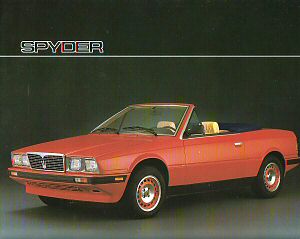 Maserati, however, preferred to entrust the development and design of the Spyder to Zagato. Starting point for the new model began with the 'platform' of the coupe, but the wheelbase was shortened from 98.97 to 94.49 ins. Maserati, however, preferred to entrust the development and design of the Spyder to Zagato. Starting point for the new model began with the 'platform' of the coupe, but the wheelbase was shortened from 98.97 to 94.49 ins.
Up to and including the door the Spyder was identical to the coupe, whilst the removal of the roof demanded a revised design for the rear section; to strengthen the rigidity of the bodyshell, allow space for the foldaway soft-top and allow for a reasonable sized boot.
The power plant remained the same until a 2.5-litre version, the 'Spyder EU' (1984-1988), primarily for the export market, was introduced in 1984 and replaced in 1989 by a 2.8-litre version, the 'Spyder iE' (1988-1989) and the 'Spyder iE90' (1990-1994).
During its production years the Spyder benefitted from the same mechanical and styling modifications as the Biturbo.
In 1985 the Biturbo underwent many changes both visual and mechanical, and became known as 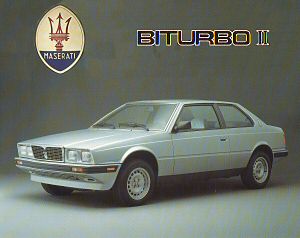 the 'Biturbo II' (1985-1987). Inside the massive rectangular instrument binnacle had disappeared, being replaced by one of elliptical shape, and the 'cheap' digital clock in the centre of the dashboard was replaced by a gold plated analogue timepiece, whose oval shape resembled the Maserati badge. Also new were the alloy wheels of a more elegant and neater design. However, in the the 'S II' version the rectangular instrument binnacle was retained and the Missoni velour upholstery replaced by a leather and Alcantara trim. the 'Biturbo II' (1985-1987). Inside the massive rectangular instrument binnacle had disappeared, being replaced by one of elliptical shape, and the 'cheap' digital clock in the centre of the dashboard was replaced by a gold plated analogue timepiece, whose oval shape resembled the Maserati badge. Also new were the alloy wheels of a more elegant and neater design. However, in the the 'S II' version the rectangular instrument binnacle was retained and the Missoni velour upholstery replaced by a leather and Alcantara trim.
Mechanically the changes were more significant with the adoption of the 'Sensitork' limited-slip differential which greatly improved the handling characteristics of the Biturbo II. Another innovation was the installation of water-cooled turbochargers, a system derived from the luxury '228' coupe, introduced in 1984; the resultant cooler turbochargers proving far more reliable.
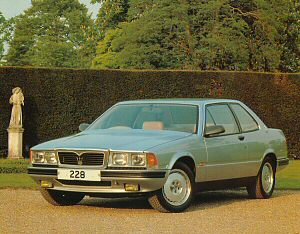 When De Tomaso first took over Maserati back in 1975, he introduced four new models; the Merak SS (phased out in 1982), the Merak 2000 (phased out in 1983), the Quattroporte III (phased out in 1990) and the Kyalami, in reality a re-styled De Tomaso Longchamp. The Kyalami was phased out in 1983, leaving Maserati without its traditional 'classy' two-door coupe. This left many of their old customers with no Maserati to chose from, so in 1986 Maserati once again entered the luxury coupe market with the introduction of the '228 Coupe' (1986-1992). When De Tomaso first took over Maserati back in 1975, he introduced four new models; the Merak SS (phased out in 1982), the Merak 2000 (phased out in 1983), the Quattroporte III (phased out in 1990) and the Kyalami, in reality a re-styled De Tomaso Longchamp. The Kyalami was phased out in 1983, leaving Maserati without its traditional 'classy' two-door coupe. This left many of their old customers with no Maserati to chose from, so in 1986 Maserati once again entered the luxury coupe market with the introduction of the '228 Coupe' (1986-1992).
The 228 was a two-door coupe powered by a fuel-injected 2.8-litre V6 engine producing 250 bhp at 5,600 rpm (225 bhp at 5,500 rpm with Kat). The 228 was longer than the standard coupe (175.59 ins instead of 163.5 ins), wider (from 73.42 against 67.48 ins) but retained the same wheelbase (102.36 ins).
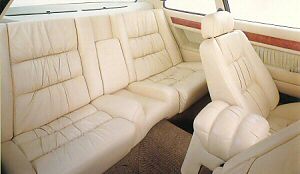 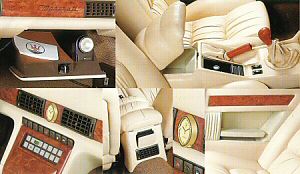
The exterior was very similar in shape to the Biturbo but with a far more softer and rounder shape. The frontal aspect had a new chrome grille, and new front side light clusters. The spacious elegant interior had anatomically designed seats upholstered in fine hand-stitched Italian leather, whilst the trim was a combination of leather and briarwood.
The Biturbo reached full maturity by the end of 1986 with the introduction of the 'Biturbo i' (1986-1988). Following lengthy research and testing, the Maserati 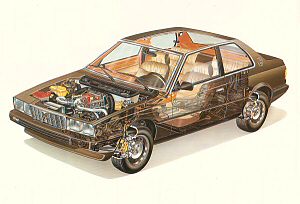 6 cylinder engine was finally equipped with a Weber/Marelli electronically controlled fuel injection and ignition system. 6 cylinder engine was finally equipped with a Weber/Marelli electronically controlled fuel injection and ignition system.
From the outside this new car was hardly distinguishable from the previous model but for the "i" badge on the rear boot lid, however, its driving temperament had radically changed. Its driveability improved greatly especially when driving around town in congested traffic, throttle response was both instant and progressive, while the chronic problem of difficulty when starting became a thing of the past.
On the "Si" version, also equipped with electronic fuel injection, the two intercooler were re-sited in front of the radiator and the NACA vents on the engine bonnet were more aesthetic than functional. A rear spoiler mounted on the boot lid not only added a sporty look but improved downforce at high speeds.
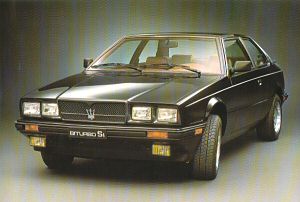 The 'Biturbo Si' (1987-1988), thanks to a power output of 220 bhp, was capable of a top speed of 145 mph. It was available in only three colours: red, grey blue metallic and black, and finished in dark grey below the character line. The interior trim, recognisable by the newly designed seats and the briarwood gear lever knob, were finished in tan leather and Alcantara for the bluey grey versions and in cream leather and Alcantara for the more expensive "Si Black" version. These were the swansong years for the Biturbo. The 'Biturbo Si' (1987-1988), thanks to a power output of 220 bhp, was capable of a top speed of 145 mph. It was available in only three colours: red, grey blue metallic and black, and finished in dark grey below the character line. The interior trim, recognisable by the newly designed seats and the briarwood gear lever knob, were finished in tan leather and Alcantara for the bluey grey versions and in cream leather and Alcantara for the more expensive "Si Black" version. These were the swansong years for the Biturbo.
1986 also saw the introduction of the '420 i' (1986-1988) and '420 Si' (1986-1988) four-door sports saloons.
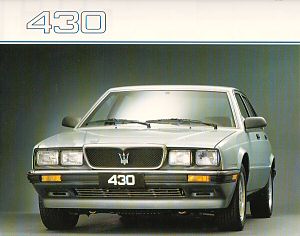
A year later saw the debut of the '430' (1987-1990), the new flagship of the "Biturbo" saloons. The 430, which adopted the same bodyshell as the 420 i, was distinguishable from its predecessor by its rounded edges giving a softer look, for its new radiator grille and frontal treatment.
The engine was the 2789cc V6 unit developing 247 bhp already in use with the 228. The 430 was fitted with the new Ranger limited slip differential, front ventilated disc brakes with floating calipers and a newly perfected type of front suspension called "Meccanica Attiva".
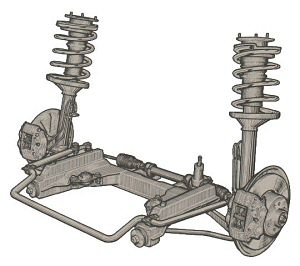 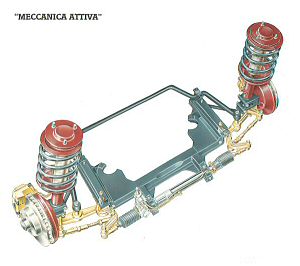
MECCANICA ATTIVA: "a sophisticated mechanism which used a system of interacting levers to
ensure that, not only did the wheels remain completely square relative to the road surface, but a state of constant parallelism is maintained between the lower suspension arm and the steering arm, no matter what vertical movement of the wheels is experienced, offering enormous advantages in vehicle stability while turning, even on rough road surfaces."
1988 saw the launch of the '422' (1988-1992), which benefitted from the improvements introduced with the 222 coupe. The ultimate evolution of Biturbo 2-litre sports saloons came in 1990 with the arrival of the 4.24v. (1990-1992) and the '4.24v 2a serie' (1991-1993).
In 1988 at the Geneva Motor Show Maserati unveiled the 'Karif' (1988-1993), a two-seater sports car based on the short wheelbase chassis, 2400mm compared to the Biturbo's 2514mm, of Zagato's pretty looking spyder, but with a fixed roof. 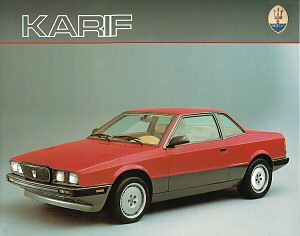 It received a mixed reception from both motoring journalists and public alike. It received a mixed reception from both motoring journalists and public alike.
The Karif was elegant but lacked the necessary move away from the 'ordinary' looking Biturbo range. It was certainly no design classic. The interior was the same blend of hand-stitched leather and polished wood as the standard Biturbo but with a polished wood-rimmed steering wheel. Standard equipment included power steering, power-operated front seats, an automatic air-conditioning system, electric windows and exterior rear-view mirrors, central locking, remote power fuel cap and boot release, a fully adjustable steering wheel, alloy wheels and the dash mounted luxury clock!!
It was certainly no slouch for its twin-turbocharged 2.8-litre V6 supposedly produced some 285 bhp (the figure published in Maserati brochures, but experts reckon it was more like 250!), without a catalytic convertor, giving it a top speed of over 155 mph. Sadly cars fitted with a catalytic convertor only developed 225 bhp (top speed 143 mph).
Also that year the title Biturbo disappeared, replaced by the title '222' (1988-1990). This model appeared to the average observer to be identical to its predecessor: however on a careful examination one could notice the softer lines, particularly in the frontal area. Mechanically nothing had altered from that incorporated in the Biturbo Si.
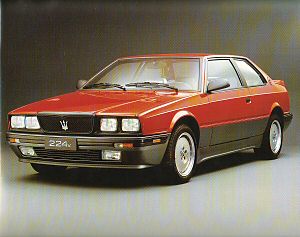 In the same year the '2.24v' (1888-1992) was launched, distinguishable from its predecessor by a number of cosmetic changes. The frontal profile incorporated a new wrap-around bumper incorporating an air grille with built-in fog lights on either side, the radiator grille was finished in matt black (as was the window trim), and the NACA vents on the bonnet were inverted. The side profile was enhanced with the addition of pronounced side-skirt and to the rear, the spoiler; now of "open" type design. The rear bumper now incorporated a horizontal vented grille allowing a smoother air flow through the undertray flanked by two small apertures to accomodate the two chromed twin tail pipes. In the same year the '2.24v' (1888-1992) was launched, distinguishable from its predecessor by a number of cosmetic changes. The frontal profile incorporated a new wrap-around bumper incorporating an air grille with built-in fog lights on either side, the radiator grille was finished in matt black (as was the window trim), and the NACA vents on the bonnet were inverted. The side profile was enhanced with the addition of pronounced side-skirt and to the rear, the spoiler; now of "open" type design. The rear bumper now incorporated a horizontal vented grille allowing a smoother air flow through the undertray flanked by two small apertures to accomodate the two chromed twin tail pipes.
The 2.24v was equipped with the traditional 2-litre engine, now fitted with new 4 valve per cylinder heads and new turbochargers giving an impressive power output of 245 bhp at 6200 rpm. The 2.24v exceeded 145 mph, accelerated from 0 to 100 kph in 5.9 seconds and could cover the standing kilometre in only 26.1 secs. At that time few cars of a comparable engine size could keep up with this 'hot' two litre!
December 1990 saw the final evolution of the Biturbo coupe, the "Racing" (1991-1992). This new model was essentially a souped-up 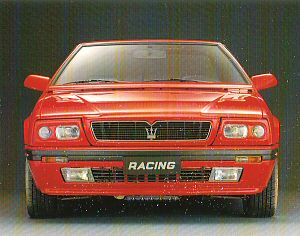 version of the 2.24v. The body remained practically the same except for a frontal face-lift, stylistically very similar to that of the "Shamal", the coupe introduced a year earlier and whose lines were the result of an effective collaboration between Maserati's design team and celebrated designer, Marcello Gandini. version of the 2.24v. The body remained practically the same except for a frontal face-lift, stylistically very similar to that of the "Shamal", the coupe introduced a year earlier and whose lines were the result of an effective collaboration between Maserati's design team and celebrated designer, Marcello Gandini.
The engine represented an evolution of the 6-cylinder, 2-litre, 24-valve unit mounted on the '2.24v': Maserati engineers had worked on the crankshaft, con-rods, pistons, compression chamber and on the turbochargers. Thanks to this careful job of sharpening the power output was raised to 285 bhp at 6250 rpm: it was then the most powerful 2-litre production engine in the world. One of the more interesting technical characteristics was the new electronically adjustable suspension system developed in collaboration with Koni, a system which automatically adjusted the shock absorbers' settings on the basis of data received from sensors mounted on each wheel. The driver however could manually select, from a four-position switch mounted in the centre console, the shock absorber setting best suited to road conditions, speed and desired comfort level.
The list price of the "Racing" was Lire 73,500,000 (around GB £34,000) and between 1991 and 1992 were only 230 examples were produced. |